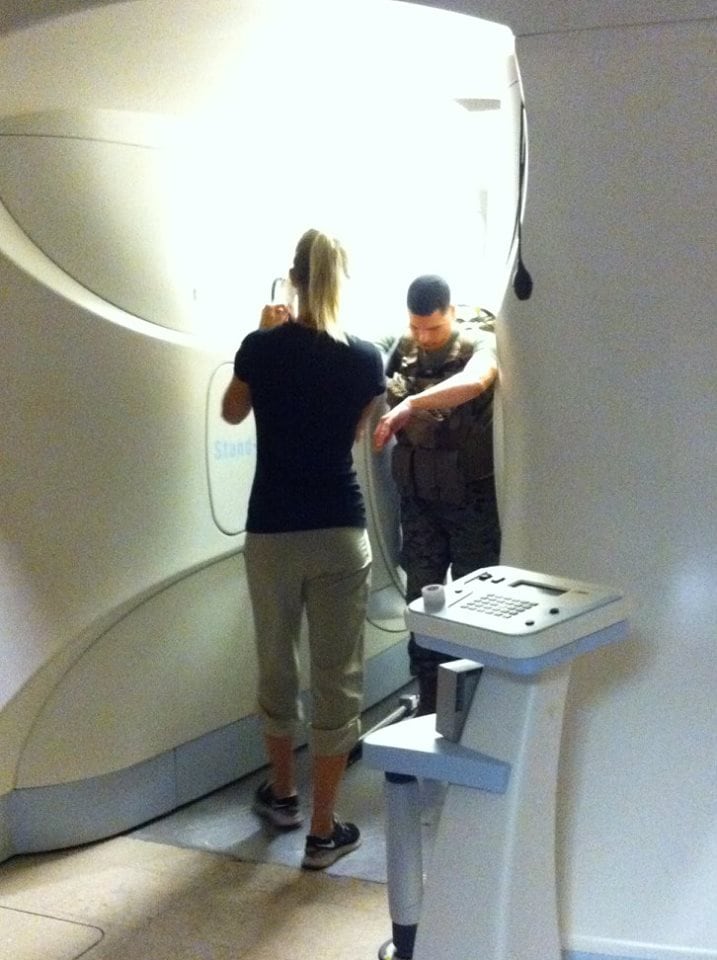A multi-year Navy study is using Magnetic Resonance Imaging to find out just how much wear and tear infantry Marines are putting on their backs in years of carrying heavy loads. The research could also help test out modifications to standard gear to help reduce the toll.
Conducted through the Naval Health Research Center, the study uses Marine volunteers with a range of experience levels to examine the impact on the spine and how the the back changes over time as they walk and stand with loaded packs. The study also had Marines sit and lie prone on their elbows under load to collect data on all positions Marines in full battle rattle might find themselves in. The multiple-phase research began in 2011 and is slated to continue at least through the end of this fiscal year.
The research is taking place on the West Coast and recently troops from 5th Marine Regiment, out of Camp Pendleton, California, have been volunteer study subjects. To date, about some 200 Marine volunteers, ranging from School of Infantry students to salty colonels, have participated so far. Officials Researchers say they need at least 65 more Marine test subjects before research is complete.
"We're looking at it from a perspective of, first of all, what's happening to the spine, how can we improve that," said Dr. Karen Kelly, a research physiologist with NHRC.
Researchers, she said, gauge the effects of load-bearing when the weight is distributed or positioned differently, with an eye to finding the most ergonomic solution for the often unavoidable requirement of packing heavy loads into combat. A current line of research uses a vertical, walk-in MRI machine, typically used for clinical research, to image the spines of Marine volunteers. Some enter the machine wearing their plate carrier vests; others wear packs loaded with weights ranging from 20 to 112 pounds, Kelly said. The high-tech machine allows the scientists to create 3-D models showing the impact of the gear on Marines' backs.
So far, said Kelly said , there has been no lack of Marines willing to participate.
"They really enjoy it," she said. "Every Marine we've had that volunteers, they've been so great. We provide them with a copy of their image if they want. We try to tell them as much as we can as they go along. They give us a lot of great feedback."

A Marine participating in a Navy-led study on the impact heavy loads have on Marines' backs stands in a vertical MRI machine.
Photo Credit: Marine Corps
While it's too early to discuss findings about the long-term effects of load-carrying on troops' backs, Kelly said researchers have found that older Marines can handle the load better. They have also been able to observe the immediate impact of loading down a Marine.
"The acute effect is, when you put a load on someone their spine changes, and when they take a rest, their spine fully recovers to normal," she said.
In previous load distribution testing, Marines have been sent through physical challenges including the combat fitness test, maneuver-under-fire exercise, and marksmanship tests. They used a redesigned plate carrier, still in the testing stages, that distributes loads more favorably for long humps and other endurance exercises. Research is planned to continue this year with small modifications to the Marines' main pack that use a modular hip belt to take some weight off the back.
To date, Kelly said, "Marines said anecdotally that [the new plate carrier] felt better on their back," Kelly said.
The multi-pronged study has also involvesd a special virtual environment, built on a high-tech treadmill, in which Marine volunteers are fitted with more than over 40 motion capture-style markers. They're asked and ask to simulate a hike under load, marksmanship tasks, and a mountainous ascent. NHRC staff can see how the loads change Marines' posture and movements as they accomplish all these tasks.
Other research has involved Marines who agreed to be imaged prior to attending the School of Infantry, mid-way through the school, and upon entry to the fleet to assess how their backs were affected in that short time period.
"The load did cause changes in the back, just biomechanical changes," Kelly said. "It was pretty interesting to see how the spine changes, and we wanted to follow that."
Kelly said NHRC works with I Marine Expeditionary Force and Marine Corps Systems Command to distribute their findings, which can be used to inform the development of new gear. Other findings are published in peer-reviewed scientific journals, she said.
